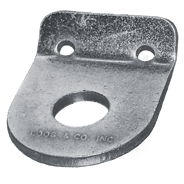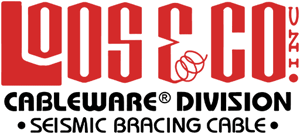What's the Difference Between SAF and SAF2 Seismic Bracing fittings?
We have discussed in our past blogs the importance of properly installing seismic bracing cable. From calculating the design and selecting the proper cable, to operating swaging tools and implementing the final installation, each stage is equally critical. Though it may seem that the cable is the most important part of the bracing system, the hardware has also has a significant impact on the way the total cable bracing system performs. That is why, in addition to retrofit hardware, we also manufacture traditional seismic anchoring fittings. Here are a few key differences between our SAF and SAF2 fittings.

SAF
SAFs (Seismic Anchoring Fittings) have many seismic sway brace applications and offer flexibility when it comes to new seismic installations. The tab hole can accommodate our #GO3 (GOLD), #OR4 (ORANGE), and #GR6 (GREEN) cable without a thimble, making them a preferred choice for architects, contractors, and engineers. The fittings are available in a wide range of bolt hole sizes, ranging from 1/4" to 7/8”, and they may be used at both ends of cables to make field cut cable assemblies.
SAF2 Our SAF2s (Seismic Anchoring Fitting - 2-Way) may be utilized for both 2-way and 4-way bracing. Like SAFs, they accommodate our gold, orange, and green cable, and come in the following bolt hole sizes: 1/4", 3/8", 1/2", 5/8", 3/4", and 7/8". When properly installed, they maintain the break strength of the cable, and they can be used for equipment connections with stake eye and cable assemblies.
Our SAF2s (Seismic Anchoring Fitting - 2-Way) may be utilized for both 2-way and 4-way bracing. Like SAFs, they accommodate our gold, orange, and green cable, and come in the following bolt hole sizes: 1/4", 3/8", 1/2", 5/8", 3/4", and 7/8". When properly installed, they maintain the break strength of the cable, and they can be used for equipment connections with stake eye and cable assemblies.
To learn how to properly install a seismic bracing system, we recommend watching the how-to video series available on our website, or downloading a copy of our free design guides. These will help ensure the hardware and cable are properly installed. For additional help, use our Engineers’ Tools seismic calculator to fill out the NFPA-13 form accurately and quickly before beginning your project. For questions about our products or seismic calculator, contact us using the form on our website.

